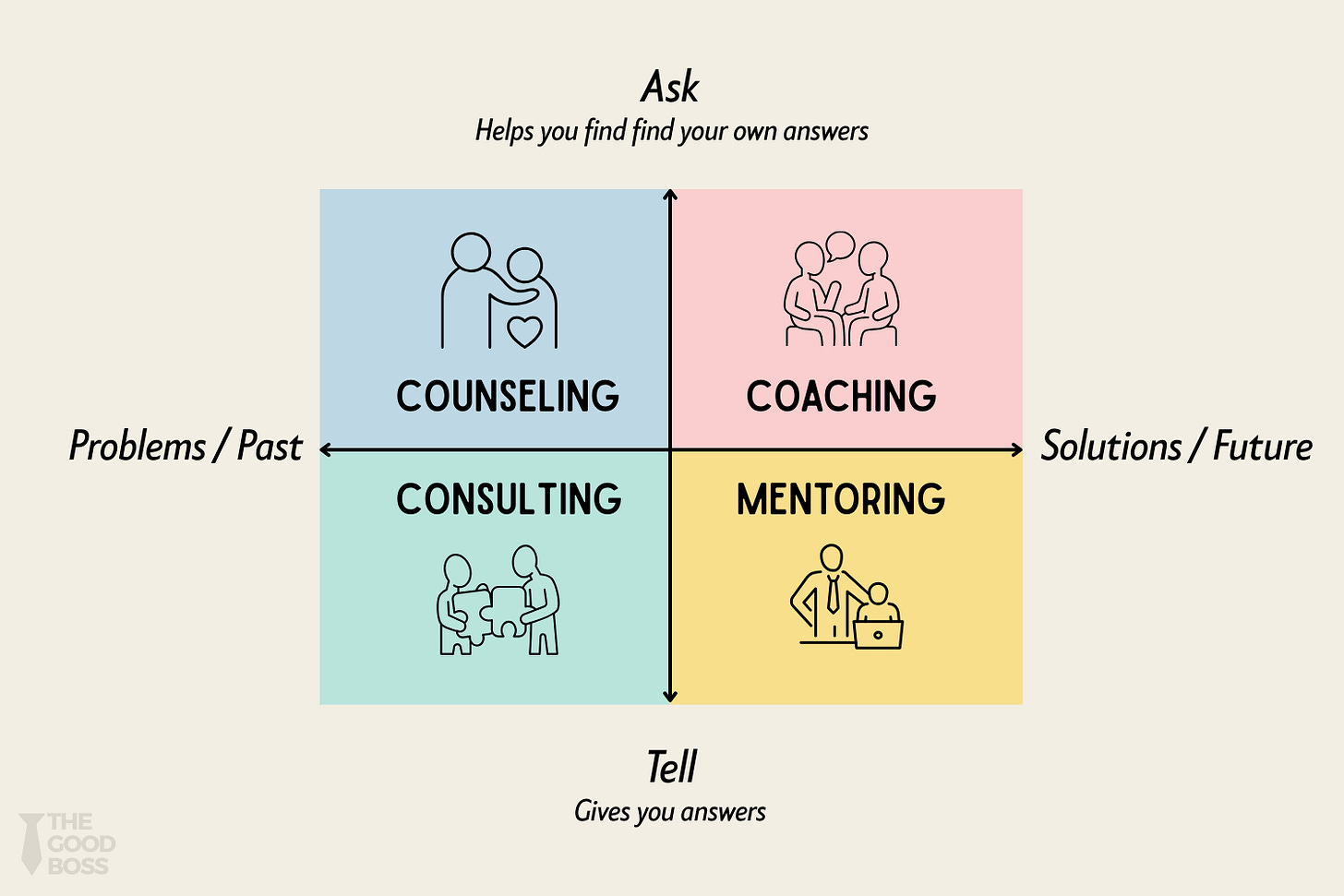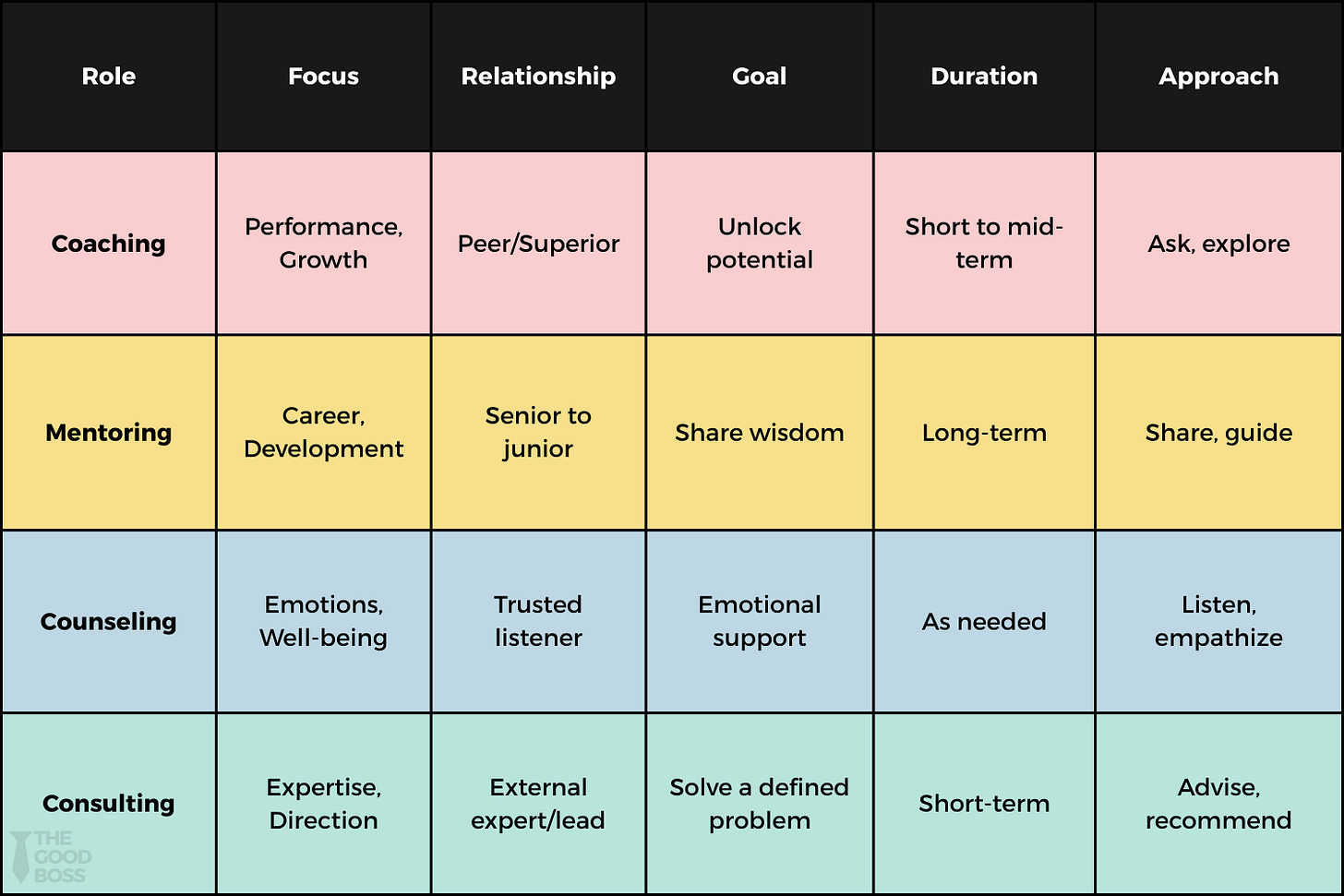The Four Leadership Support Roles: Coaching, Mentoring, Counseling, Consulting
Know When and How to Apply these Roles in Leadership
In this issue:
Part 1: Understanding The Four Leadership Support Roles
The Support Matrix
Deep Dive: Coaching, Mentoring, Counseling, Consulting
Part 2: Choosing The Right Role For You
The 3-C Question Framework
Real-Life Leadership Scenarios
The Four Roles of a Leader Worksheet
Part 3: Going from here
Common Pitfalls and How to Avoid Them
Recommended Resources
Final Takeaway
✨
"I’m not sure what he needs from me right now."
That was the thought running through my head in the middle of a one-on-one.
I had just been promoted to a management role in a software company. The person sitting across from me was a smart, capable engineer. But something was off. He wasn’t meeting his goals, and the energy just felt low. And everything I said - encouragement, feedback, even technical tips - didn’t seem to work.
As his manager, I felt compelled to try to ‘fix’ it. I tried to offer advice and give him space. I even tried to push a bit harder.
Nothing worked.
Later, I realized the problem wasn’t that I wasn’t doing enough. It was that I was doing the wrong thing.
What he needed wasn't a boss with answers. He needed a coach. Or maybe a mentor. Or maybe he was dealing with something personal and needed to talk.
Back then, I didn’t know the difference. And neither do a lot of managers.
In this post, I will break down the four distinct support roles of a leader - how they differ, when to apply which, and how to apply them to be most effective as a leader.
Part 1: Understanding The Four Leadership Support Roles
In this section, we will learn about The Support Matrix, and how the four leadership support roles stack up against each other.
The Support Matrix
I find the easiest way to understand these four roles is to plot them on a 2x2 matrix, which I call The Support Matrix.
The X-axis runs from Problems/Past on the left to Solutions/Future on the right. The Y-axis runs from Tell (you give answers) at the bottom to Ask (you help others find their own answers) at the top.
Coaching sits in the top-right quadrant: it’s all about asking questions that help the other person move toward a future-oriented solution.
Mentoring is bottom-right: you're offering guidance and sharing experiences to help someone grow into their future.
Counseling lands in the top-left: here, you're listening and asking reflective questions to help someone explore their past or inner emotional challenges.
Consulting fits in the bottom-left: you’re analyzing and advising, often using your expertise to diagnose and solve past or current problems.
The Support Matrix helps you decide not just what role to play, but how to show up in that conversation.
Here’s another breakdown of how these roles stack up against each other. Use it as a reference to guide you in your next conversation:
Deep Dive: Coaching, Mentoring, Counseling, Consulting
Now that we understand the roles at a high level, let’s dive deep into each one to understand them a bit better.
Coaching: Unlocking Potential Through Questions
Coaching is about helping someone discover the answer for themselves.
You’re not telling them what to do. You’re helping them see their own roadblocks—and then step over them.
This works best when the person has the skill but not the confidence, clarity, or motivation.
Think of coaching like holding up a mirror. You're not directing. You're reflecting.
When to Coach
Your teammate is capable but stuck
They need clarity, not answers
You want them to own the outcome
How to Coach
Use questions that help them think:
“What’s the real challenge here for you?”
“What options have you considered?”
“What would success look like?”
“What’s stopping you?”
Try This Framework: GROW
GROW is one of my favorite tools. I’ve written about it in The Leader’s Playbook (Chapter 14). Here’s how it works:
Goal: What do you want to achieve?
Reality: Where are you now?
Options: What could you do?
Will: What will you do?
It’s simple. But it works like magic when done well.
Other great coaching frameworks you can explore:
CLEAR – great for building rapport
FUEL – helpful in structured follow-ups
When to Use Coaching as a Leader
In 1:1s for performance improvement
When your teammate is exploring a challenge
When you're tempted to solve, but it's better they own the solution
Mentoring: Sharing Experience to Guide Others
Mentoring is more relaxed, longer-term, and focused on growth—not tasks.
It’s about sharing your story so someone else can learn from your journey. The goal isn’t to give all the answers. It’s to spark ideas, challenge assumptions, and support the next steps.
When to Mentor
Someone wants career direction
They’re looking for advice, not performance help
You’ve walked the path they want to walk
How to Mentor
Share stories (especially failures!)
Ask thoughtful questions: “What do you want long-term?”
Offer perspective (from your experience), not prescriptions
Great mentors are generous with their lessons—but humble about the fact that others may choose a different path.
When Leaders Should Mentor
You’re building a pipeline of future leaders
You want to support growth across teams
You’re asked to mentor someone outside your team (a great sign of your leadership!)
Counseling: Supporting Through Emotional Challenges
Let’s be clear: You are not a therapist.
But you are a human being. And good leaders create space for emotional conversations, especially in today’s world.
Counseling is about listening, not solving.
It’s about holding space. Sometimes, that’s all people need.
When to Counsel (or Listen)
A teammate is showing signs of burnout or stress
Performance is slipping and the person doesn’t respond to coaching
There’s a personal issue that’s affecting their work
How to Approach Counseling Conversations
Create safety: “I’ve noticed something feels off. Want to talk?”
Be quiet more than you speak
Don’t rush to fix
Know when to recommend professional help (e.g., company EAP or therapist)
Tools like Radical Candor or the SBI model (Situation–Behavior–Impact) help you open the conversation respectfully and clearly.
When Leaders Should Use a Counseling Approach
A teammate opens up emotionally in a 1:1
You notice someone withdrawing or disengaging
You’re in a difficult feedback conversation where emotions come up
Consulting: Offering Expertise to Solve a Problem
Consulting is what most managers default to. It’s comfortable. It feels productive.
But it's not always what people need.
Still, there’s a time for it. When you do have the expertise, or the issue is urgent, it’s okay to take the driver’s seat.
When to Consult
The team lacks knowledge or context
The problem is technical or specialized
They want you to make the call or bring in someone who can
How to Be a Great Consultant (When Needed)
Be clear and direct
Focus on solutions, not symptoms
Back up your advice with examples or data
Be available for follow-up questions
When Leaders Should Use Consulting
Launching a new product/platform
Building a strategy and needing direction
Helping your team choose tools or vendors
Enjoying the read? Hit the ❤️ button and share/restack 🔁 it with others who might find it helpful.
Subscribe to The Good Boss to get leadership insights and frameworks like this every week. Consider becoming a paid subscriber to support my work, and get access to a host of premium leadership resources. Thank you! 🙏
Part 2: Choosing The Right Role For You
In this section, you will learn how to choose the right role in the given situation as a leader.
We will start by learning about the 3-C Question Framework, which can make it really easy for you to identify the right role by asking simple, insightful questions.
We will then discuss some common real-life leadership scenarios, and how you would apply the various support roles in different situations.
Finally, we will make it real with The Four Roles of a Leader Worksheet, which will help you build your muscle in applying those roles in real situations at work.







